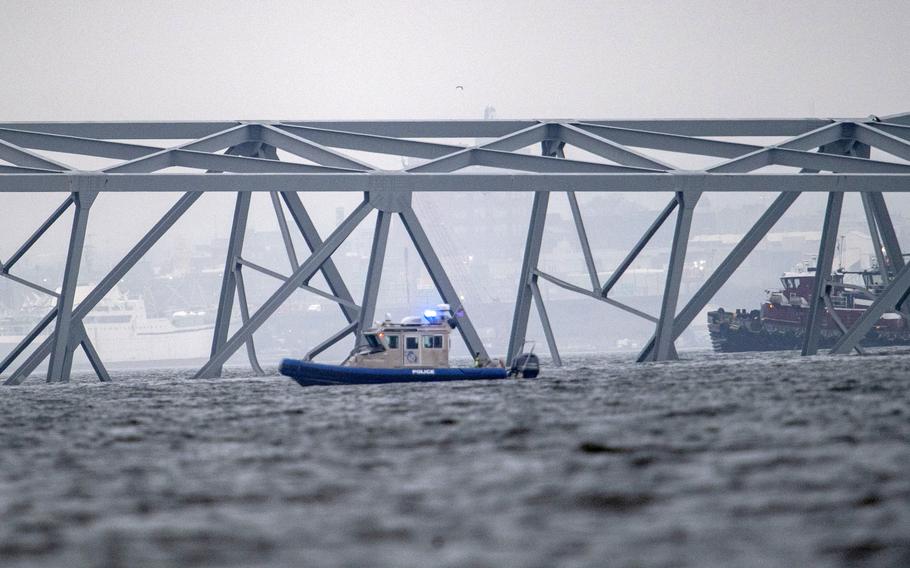
Authorities are turning their focus to salvage operations to remove wreckage from the Patapsco River after the massive container ship Dali caused Baltimore’s Francis Scott Key Bridge to collapse. (Jonathan Newton for The Washington Post)
Maryland will have access to federal money in a matter of days to pay for the start of the Francis Scott Key Bridge recovery and rebuilding mission, but longer-term funding from Congress could take months to arrive, Sen. Chris Van Hollen (D-Md.) told The Washington Post on Thursday.
Maryland transportation officials asked for federal emergency relief funds Wednesday, and Gov. Wes Moore (D) had earlier declared a state of emergency, making Maryland eligible for quick access to hundreds of millions of dollars in aid. On Thursday, the state requested an initial payment of $60 million for early recovery and cleanup.
Federal agencies, including the Army Corps of Engineers, will assume the full cost of clearing shipping lanes in the Patapsco River to reopen the vital Port of Baltimore, Van Hollen said.
“That’s obviously a very, very big commitment, and they will cover all of those costs,” Van Hollen said.
But Maryland taxpayers could be left to foot some of the costs, based on the structure of the U.S. Department of Transportation’s emergency relief fund. Maryland’s congressional delegation is planning to introduce legislation for more federal dollars to cover any gap, but it would have to pass both chambers of Congress. It’s not year clear how much the total cost might be, or how much the relief fund might leave for the state to pay.
President Biden said earlier in the week that federal government should pay for the full amount to restore the waterway and erect a new bridge.
“When it comes to using those funds for the design and ultimately the construction of new bridge, there’s a cost share where the federal government picks up the lion’s share of the costs, but not all of it,” Van Hollen said. “And that’s where Senator [Ben] Cardin and I plan to introduce legislation to ensure that the federal government is able to pick up the full costs going forward.”
Cardin (D) told The Post he’d received messages of support from Republican colleagues in Congress, which made him hopeful that legislation to support Baltimore would not face political roadblocks.
“We expect that Congress will come to our help,” he said. “When you have a catastrophic event affecting infrastructure of this type, the federal government needs to be there, has been there in the past, and we expect it will be there for Baltimore for the replacement bridge.”
Money from the federal Transportation Department’s emergency relief fund will cover Maryland’s costs to divert traffic away from the collapsed portion of I-695, the major thruway that used the Key Bridge, and for the design and rebuild of a new structure, Van Hollen said.
Under the relief program, the federal government pays for 90 percent of repairs, while the state is responsible for the remaining 10 percent. But federal agencies will reimburse 100 percent of repair work conducted in the first 270 days after a disaster to restore essential travel ways, minimize damage or protect remaining facilities.
Such a large outlay for the bridge crisis may hurt the long-term viability of the emergency relief fund, Van Hollen added. Biden’s 2021 Infrastructure Investment and Jobs Act provided $100 million a year to the program.
“The emergency relief fund will need to be plussed up, not just for this Baltimore bridge replacement, but for other projects that it supports,” Van Hollen said. “That will be something that we will be working closely with the White House to accomplish.”
Policymakers have already begun discussing raising the height of a new bridge, he said, and incorporating new technology to make the structure safer. The 47-year-old Key Bridge was constructed without any “redundancy” that would keep it from toppling if a major support was struck, National Transportation Safety Board Chair Jennifer Homendy said.
Van Hollen said he has communicated with Sen. Tom Carper (D-Del.), whose Environment and Public Works Committee has jurisdiction over federal highways, and congressional appropriators about a funding bill. He and Cardin have sought a call with House Speaker Mike Johnson (R-La.), but have not yet spoken, Van Hollen said.
Congressional spending for Maryland, though, could take months to pass, even if things flow smoothly on Capitol Hill.
Lawmakers will need a request from the Biden administration and Maryland officials with a firm dollar figure to begin crafting an emergency spending, or appropriations, package. Congress just passed full-year funding for the federal government before the bridge disaster, so new money would need a separate spending bill.
It’s not yet clear how long federal and state officials will need to draw up plans for a new bridge. And lawmakers are in the midst of a two-week recess in the home districts, set to return to Washington to take up other pressing spending priorities - including U.S. support for Ukraine and Israel — the second week of April.
A Maryland aid bill could get a boost due to changes on the House’s powerful Appropriations Committee. Rep. Tom Cole (R-Okla.), head of the panel’s Transportation subcommittee, is the front-runner to take over as the full committee’s chair. Cole is well-liked among Democrats for his bipartisan streak and institutional knowledge.
Maryland also has robust representation on the panel; half of the state’s House delegation sits on the committee.
Rep. Andy Harris (R) chairs another subcommittee, and Rep. Steny H. Hoyer (D) is one of the longest-serving members on the panel, commanding significant influence on federal spending. Rep. Dutch Ruppersberger (D), whose district surrounds the city of Baltimore, and Rep. David Trone (D), whose district covers Western Maryland and reaches Baltimore’s outermost suburbs, also sit on the Appropriations Committee.